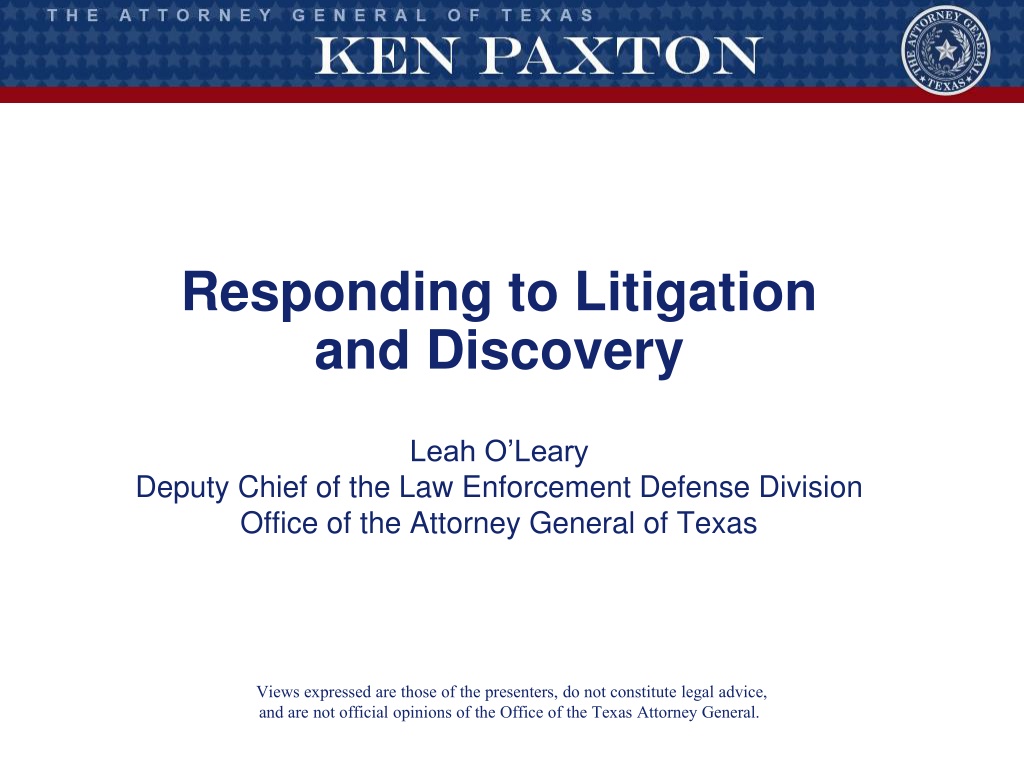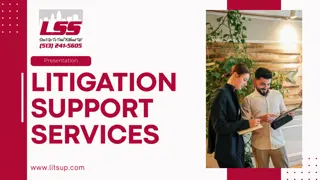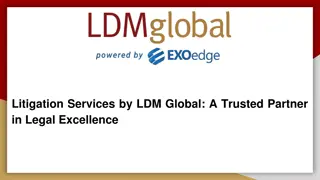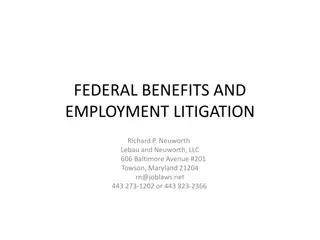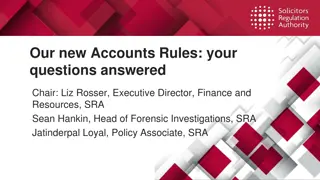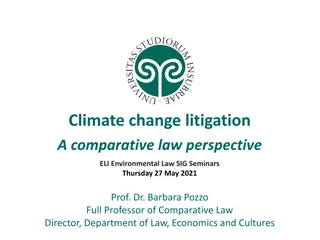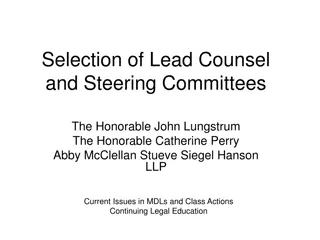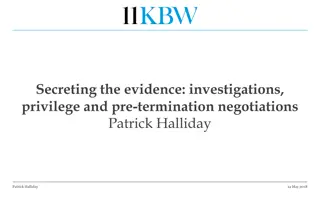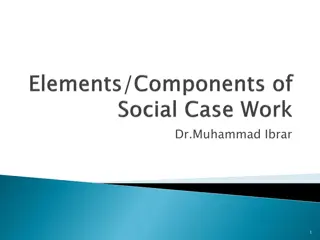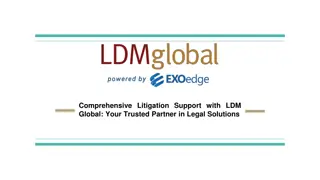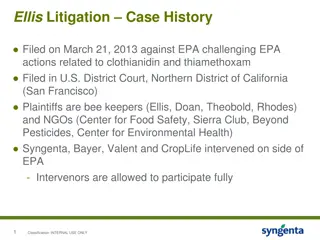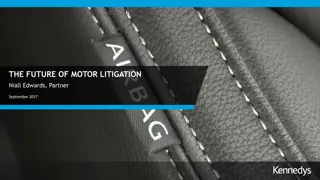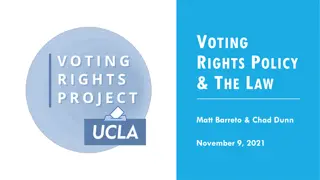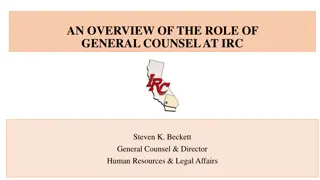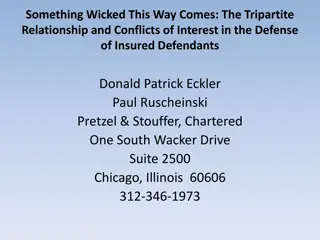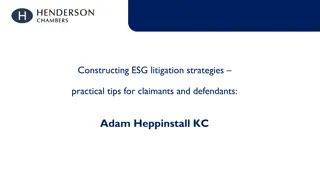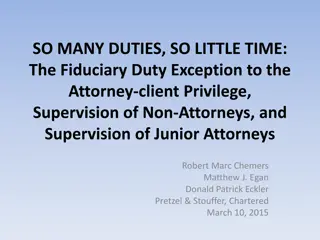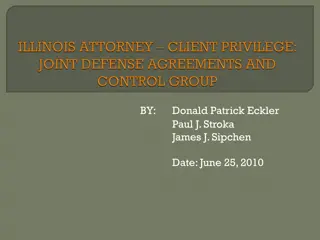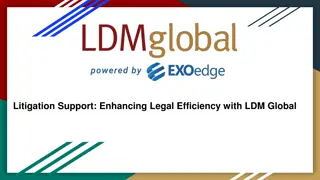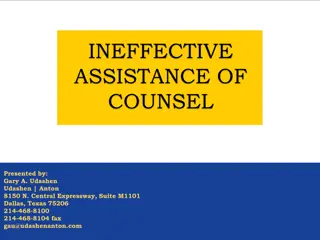Effective Collaboration Between Client Agency and Litigation Counsel
Establishing clear expectations, defining roles, and facilitating communication are crucial in developing a successful working relationship between a client agency and litigation counsel. This collaboration ensures efficient handling of evidence, response to discovery requests, and communication with agency witnesses. Effective communication and delineation of responsibilities between the client agency and litigation counsel are essential for a streamlined legal representation process.
Download Presentation

Please find below an Image/Link to download the presentation.
The content on the website is provided AS IS for your information and personal use only. It may not be sold, licensed, or shared on other websites without obtaining consent from the author. Download presentation by click this link. If you encounter any issues during the download, it is possible that the publisher has removed the file from their server.
E N D
Presentation Transcript
Responding to Litigation and Discovery Leah O Leary Deputy Chief of the Law Enforcement Defense Division Office of the Attorney General of Texas Views expressed are those of the presenters, do not constitute legal advice, and are not official opinions of the Office of the Texas Attorney General.
When Does the OAG Represent State Actors? There must be statutory authority for the Office of the Attorney General (OAG) to represent an individual or an agency. This authority can be found in several places. Texas Civil Practice & Remedies Code 104.004. Defense by Attorney General: The attorney general shall defend a public servant or estate listed in Section 104.001 in a cause of action covered by this chapter. General Appropriations Act 16.01(a)(1) The Attorney General shall have the primary duty of representing the State in the trail of civil cases. The AG decides whether the representation is appropriate. Texas Government Code 402.0212. That decision often revolves around whether State funds are at stake.
Establishing Expectations The first step to a successful working relationship between the OAG and the client agency is to establish expectations of each other. In some circumstances, your expectations may be the same for all cases. While in others, your expectations may vary from case to case. For example, a client agency may expect to receive a draft of every filing in every case before it is filed. But for some, a client agency may expect to review drafts of filings for only those cases that it deems significant. It is important that the client agency and the OAG establish what those expectations are from the beginning.
Now that you have litigation counsel Once an attorney-client relationship has been formed between the client agency and litigation counsel, a client agency and/or its general counsel should help litigation counsel determine what types of evidence may exist relating to the claims at issue. You are in the best position to know what types of records your agency creates and which employees may have knowledge about the incident giving rise to the case. For example, litigation counsel may not be aware that there is a risk manager that would have reviewed an incident and created a report, so counsel may not know to ask specifically for risk management records or to speak to the risk manager. Make sure you are being proactive and think broadly about what litigation counsel may need to know.
Who Will Do What? A discussion you should have with your litigation counsel at the outset is who will handle what. Examples: Will litigation counsel contact agency witnesses directly, or would general counsel prefer to make those contacts? When discovery requests for production come in, who at the agency will take care of gathering the necessary documents? When written interrogatories or requests for admissions come in, who will be the primary drafter of the answers? Will litigation counsel draft objections first or will the agency provide responses first?
What does litigation look like? Trial 6 Dispute Resolution 5 Discovery 4 Investigation 3 Lawsuit is Filed Pre-Litigation 2 1
Records can make or break a case. Records issues impact the odds negatively or positively at trial. When the government is a defendant, a jury has high expectations. The government is held to a higher standard. Jurors can be particularly distrusting of government parties when the paperwork is not in order. When the government agency being sued has a document to back up the story, it increases the likelihood that a juror has no reason to doubt that story. But the converse is also true: when there is not a document to back up a story, it is easy for a juror to start thinking about the C word: Conspiracy. The government is covering something up.
LITIGATION HOLDS A Litigation Hold, also called a Notice to Retain, is a written notice to employees and custodians of records that there is existing litigation or litigation is expected. A Litigation Hold explains to the recipient his or her duty to preserve records that may be relevant to the litigation.
Litigation Holds Keep Litigation Holds short-ideally 2 pages or less Use words that your custodians will understand and don t use legal jargon. Involve your IT people. For example, have IT do a keyword search of employees emails for communications relevant to the lawsuit. BUT, employees likely to have relevant emails should still take steps to retain relevant emails. Does your agency have a 30-day retention on emails? Employees probably need to create a litigation hold email folder that has longer or permanent retention. Remember that your retention policy does not apply if there is a litigation hold.
LITIGATION HOLDS Although it is a good idea for your agency to disseminate a Notice to Retain or Litigation Hold, you may ask the OAG attorney representing you to draft a detailed and case-specific litigation hold. The OAG will need your help to disseminate the Litigation Hold to the necessary people. Remember, you know your agency best, so you can help determine which employees may have relevant records. Remember that records can be paper, video recordings, audio recordings, text messages, call logs, hand-written notes, instant messages, and many other types. Your Litigation Hold should explain this so that a layman will understand.
No Records Affidavits. Should We or Shouldn t We? A no records affidavit (NRA) is a signed and notarized document in which the affiant testifies that he or she is the custodian of records and that through a diligent search of the business records, the affidavit found no records. NRAs can be dangerous because (1) they are sworn testimony; and (2) records can often be identified or found later.
When Should You Create a No Records Affidavit? As a general rule, no records affidavits should be avoided. But of course, there are exceptions. If your litigation counsel requests records, and your normal practice is to produce a no records affidavit as the method of letting counsel know that you didn t find any records, you should consider just sending an email instead. That way, the statement (1) is not sworn testimony; (2) is probably attorney-client privileged communication, and (3) won t have such severe consequences if records are found later. There are exceptions. Example: Litigation counsel needs a no records affidavit for all offender grievances submitted from January 1, 2019 to present date in order to demonstrate to the court that the offender failed to exhaust administrative remedies prior to filing suit. How do you know what situations call for a no records affidavit? Consider making it your default NOT to create a business records affidavit in response to a request for records unless one is specifically requested. Communicate this to your litigation counsel.
Planning for Successful Defense. There are steps that the client agency or general counsel can take to help litigation counsel build a strong case. Make sure witnesses are identified and accounted for. Are they still with the agency? Have they left employment? Make sure you identify witness statements early and provide them to litigation counsel. Finding a witness statement late in the litigation can be disastrous. Manage and monitor internal communications relating to the claim. These types of communications might not be privileged or confidential. Put together a succinct timeline of the key events. If possible, include references to evidence that supports each point in the timeline.
Early Case Assessments Work with your AAG to conduct an early case assessment to create a strategic road map for the matter. This ties back to the first step of establishing expectations. What are the agency s goals? Are there broader repercussions that may arise from this lawsuit? Are there any immediate steps that the agency or the AAG need to take? What resources will be needed to defend this case? Do we need an expert? Do we need an investigator?
How to Approach Disagreements There may be instances where you, the client agency, does not agree with a strategy, or decision that the assigned Assistant Attorney General has made. Although everyone shares the main goal of getting a case against you dismissed, the state agency and the OAG may also have varied goals. Of course ideally, litigation counsel and the client agency will be able to discuss and resolve any disagreements. Try having face-to-face discussions rather than phone conferences or emails. Discuss legal precedent and examples on both sides of the issue. Escalate the discussion to superiors if necessary. There may be issues at play that you are not aware of.
Part of the analysis You, state agencies, are typically the State s delegate for managing the state program or state action that is the subject of the lawsuit. So agencies are important in determining the State s interests in the future management of the state program or state action. Also, in a settlement with a state agency, the Governor, the Comptroller, and the Legislature have a say, depending on the amount and source of the funds.
Here are some relevant statutes that address these situations: The AG decides whether the agency can use outside counsel. Texas Government Code 402.0212 and General Appropriations Act 16.01(a)(2). An agency cannot act in litigation without AG consent. General Appropriations Act 16.01(b). The AG approves the content of settlements. General Appropriations Act 16.01(d). And ultimately, the AG can act over the objection of the agency. Bullock v. Escobedo, 583 S.W2d 888 (Tex. App. Austin 1979, writ ref d).
Ultimately, the relationship between you and the OAG is a partnership. You are the experts on your agency, its functions, and its goals. The OAG lawyers are the experts on the law, the art of litigation, and the State fisc. Together, we have the best chance of a successful outcome in litigation.
